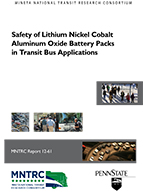Abstract:
The future of mass transportation is clearly moving toward the increased efficiency and greenhouse gas reduction of hybrid and electric vehicles. With the introduction of high-power/high-energy storage devices such as lithium ion battery systems serving as a key element in the system, valid safety and security concerns emerge. This is especially true when the attractive high-specific-energy and power-chemistry lithium nickel cobalt aluminum oxide (NCA) is used. This chemistry provides great performance but presents a safety and security risk when used in large quantities, such as for a large passenger bus. If triggered, the cell can completely fuel its own fire, and this triggering event occurs more easily than one may think.
To assist engineers and technicians in this transfer from the use of primarily fossil fuels to battery energy storage on passenger buses, the Battery Application Technology Testing and Energy Research Laboratory (BATTERY) of the Thomas D. Larson Pennsylvania Transportation Institute (LTI) in the College of Engineering at The Pennsylvania State University partnered with advanced chemistry battery and material manufacturers to study the safety concerns of an NCA battery chemistry for use in transit buses. The research team ran various experiments on cells and modules, studying rarely considered thermal events or venting events. Special considerations were made to gather supporting information to help better understand what happens, and most importantly how to best mitigate these events and/or manage them when they occur on a passenger bus.
The research team found that the greatest safety concern when using such a high-energy chemistry is ensuring passenger safety when a cell’s electrolyte boils and causes the ventilation of high-temperature toxic material. A cell-venting event can be triggered by a variety of scenarios with differing levels of likelihood. Also, though the duration of a venting event is relatively short, on the order of just a few seconds, the temperature of the venting material and cell is extremely high. During a venting event, the high-pressure, burning gases tend to burn holes in nearby packaging materials. Most interestingly, the team discovered that following a venting event the large-format cells tested immediately reached and remained at extremely high external skin temperatures for very long periods, on the order of hours. The majority of this report covers the testing designed to better understand how high-energy cells of this chemistry fail and what materials can be used to manage these failures in a way that increases passenger survivability.
Publications:
Authors:
TIMOTHY CLEARY, MS
Timothy Cleary is the director of the Battery Application Technology Testing & Energy Research Laboratory (BATTERY) at the Larson Institute at Penn State. He earned his B.Sc. and M.S. degrees in mechanical engineering from Penn State. He is involved in the U.S.DOE-sponsored Advanced Vehicle competitions serving as team leader for the 2007-2008 competition and currently an assistant faculty advisor to the current PSU team. In 2009-2010 he was a vehicle systems and simulation contracted engineer supporting U.S. DOE research in the area of plug-in hybrid electric vehicles. In 2010-2011 he gained Top Secret security clearance and assisted the U.S. Army’s Seeker Effects Laboratory in performing infrared countermeasure testing. Currently he concentrates his research in battery system development and application testing for advance chemistry automotive batteries ranging from starter to full electric buses.
MARC SERRA BOSCH
Marc is an international student from Barcelona who was in an exchange program for his master’s degree in Investigation. He graduated in Mechanical Engineering at Institut Químic de Sarrià (IQS), and his interests are mostly focused on different aspects of the vehicle industry, such as the implementation of alternative energies, active vehicle safety systems, and vehicle testing.
JIM KREIBICK
James A. Kreibick earned his BS in Electrical Engineering from Penn State. His studies focused on control systems and power systems. During his time at Penn State he was involved in the Penn State Advanced Vehicle team that participated in the EcoCar2 competition sponsored by General Motors and the Argonne National Laboratory. He also spent three years working on battery research with the Pennsylvania Transportation Institute that included two funded research projects from MNTRC and Norfolk Southern Corporation. These projects ranged from battery testing and hardware in the loop testing to battery modeling. He intends to join industry related to energy storage and power transmission.
JOEL ANSTROM, PH.D.
Dr. Joel R. Anstrom is Director of the Hybrid and Hydrogen Vehicle Research Laboratory and the DOE Graduate Automotive Technology Education Program at the Thomas D. Larson Pennsylvania Transportation Institute at Penn State University. He is responsible for developing and managing transportation research projects that advance hybrid electric and fuel cell vehicles, hydrogen fueling infrastructure, and high-power in-vehicle energy storage. His research focus is modeling and demonstration of electric, hybrid electric, and fuel cell vehicles for efficiency and dynamic handling.
Dr. Anstrom earned B.S. and Ph.D. degrees in Mechanical Engineering from Penn State University and a Master’s degree in Manufacturing Systems Engineering from the University of Texas at Austin.


